New statues of astronaut Neil Armstrong have been unveiled and an education center has been dedicated in his name as his Ohio hometown continues celebrating its native son's history-making moon mission 50 years ago this month.
The Dayton Daily News reports Republican Gov. Mike DeWine and other officials gathered at the Armstrong Air and Space Museum in Wapakoneta (wah-puh-kuh-NET'-uh) for the unveiling Sunday of a bronze life-sized statue of Armstrong as a test pilot. A statue of him as a boy also was unveiled.
A ribbon-cutting dedicated the Armstrong STEM Inspiration Center at the museum. It will promote science, technology, engineering and math learning.

The boyhood home of astronaut Neil Armstrong is commemorated by a sign on its front yard, Wednesday, June 26, 2019, in Wapakoneta, Ohio. Very down to earth about most things, folks in this small western Ohio city are over the moon as they get ready to celebrate the 50th anniversary of the day they watched their hometown hero along with the world. Neil Armstrong put Wapakoneta on the map in July 1969 when he became the first human to walk on the moon. (AP PhotoJohn Minchillo)
Armstrong stepped on the moon's surface July 20, 1969. A celebration of the moon landing which had already begun continues through July 21 in the western Ohio city.
Follow AP's full coverage of the Apollo 11 anniversary at: https://apnews.com/Apollo11moonlanding
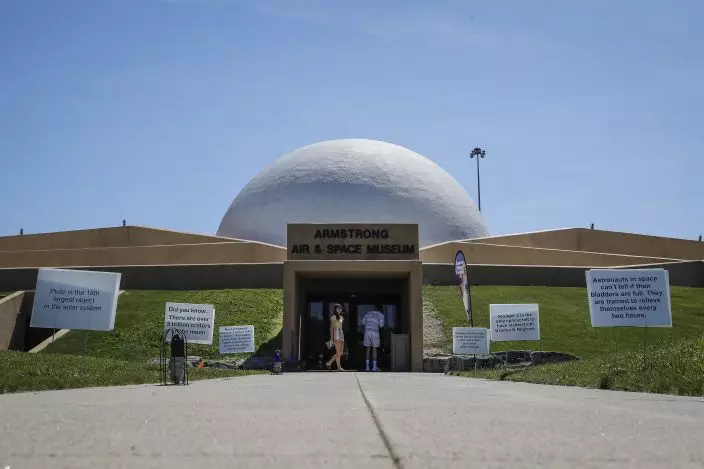
Visitors linger outside the Armstrong Air & Space Museum, Wednesday, June 26, 2019, in Wapakoneta, Ohio. Neil Armstrong helped put Wapakoneta on the map July 20, 1969, when he became the first human to walk on the moon. The late astronaut remains larger than life in the city 60 miles (96.56 kilometers) north of Dayton, where visitors are greeted by the space base-shaped top of the space museum named for him as they exit Interstate 75. (AP PhotoJohn Minchillo)
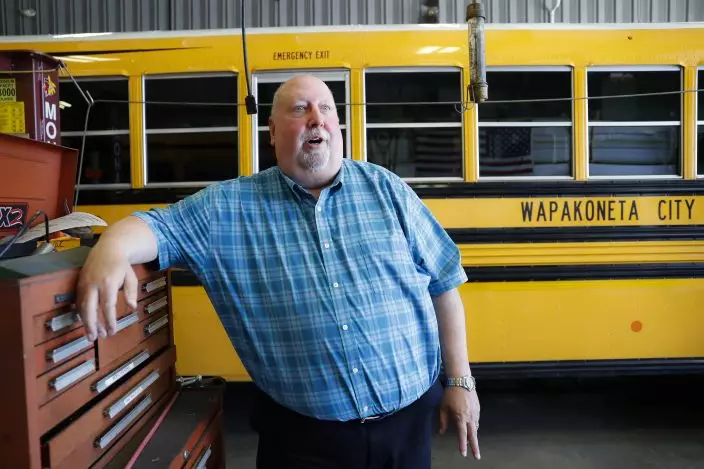
Dave Tangeman speaks of his memories of astronaut Neil Armstrongs famous Apollo 11 moon landing during an interview at his workplace, Wednesday, June 26, 2019, in Wapakoneta, Ohio. Very down to earth about most things, folks in this small western Ohio city are over the moon as they get ready to celebrate the 50th anniversary of the day they watched their hometown hero along with the world. Neil Armstrong put Wapakoneta on the map in July 1969 when he became the first human to walk on the moon. (AP PhotoJohn Minchillo)

Patches adorn the spacesuit worm by astronaut Neil Armstrong for the Gemini VIII mission at the Armstrong Air & Space Museum, Wednesday, June 26, 2019, in Wapakoneta, Ohio. Neil Armstrong helped put Wapakoneta on the map July 20, 1969, when he became the first human to walk on the moon. The late astronaut remains larger than life in the city 60 miles (96.56 kilometers) north of Dayton, where visitors are greeted by the space base-shaped top of the space museum named for him as they exit Interstate 75. (AP PhotoJohn Minchillo)
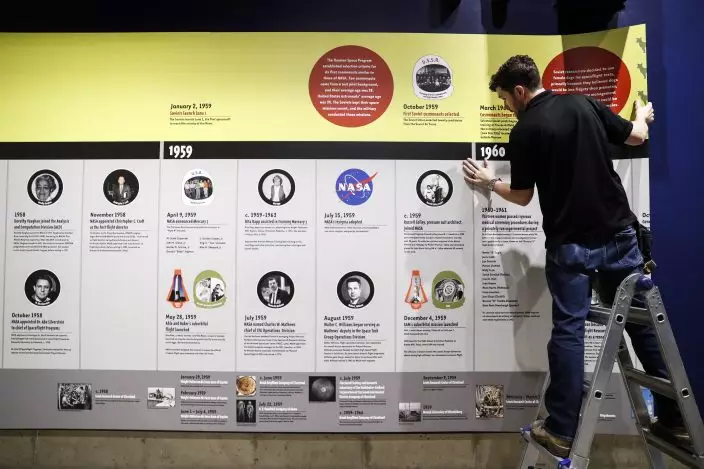
A workman prepares a display at the Armstrong Air & Space Museum, Wednesday, June 26, 2019, in Wapakoneta, Ohio. Very down to earth about most things, folks in this small western Ohio city are over the moon as they get ready to celebrate the 50th anniversary of the day they watched their hometown hero along with the world. Neil Armstrong put Wapakoneta on the map in July 1969 when he became the first human to walk on the moon. (AP PhotoJohn Minchillo)

Visitors browse an exhibit featuring the Gemini VIII spacecraft at the Armstrong Air & Space Museum, Wednesday, June 26, 2019, in Wapakoneta, Ohio. Neil Armstrong helped put Wapakoneta on the map July 20, 1969, when he became the first human to walk on the moon. The late astronaut remains larger than life in the city 60 miles (96.56 kilometers) north of Dayton, where visitors are greeted by the space base-shaped top of the space museum named for him as they exit Interstate 75. (AP PhotoJohn Minchillo)
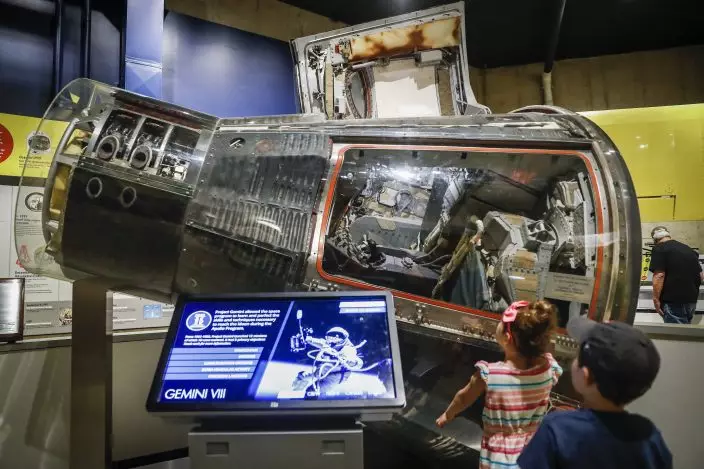
Visitors look on the Gemini VIII spaceship at the Armstrong Air & Space Museum, Wednesday, June 26, 2019, in Wapakoneta, Ohio. Very down to earth about most things, folks in this small western Ohio city are over the moon as they get ready to celebrate the 50th anniversary of the day they watched their hometown hero along with the world. Neil Armstrong put Wapakoneta on the map in July 1969 when he became the first human to walk on the moon. (AP PhotoJohn Minchillo)

Henry Cook plays inside a Lunar Landing Simulator at the Armstrong Air & Space Museum, Wednesday, June 26, 2019, in Wapakoneta, Ohio. Very down to earth about most things, folks in this small western Ohio city are over the moon as they get ready to celebrate the 50th anniversary of the day they watched their hometown hero along with the world. Neil Armstrong put Wapakoneta on the map in July 1969 when he became the first human to walk on the moon. (AP PhotoJohn Minchillo)
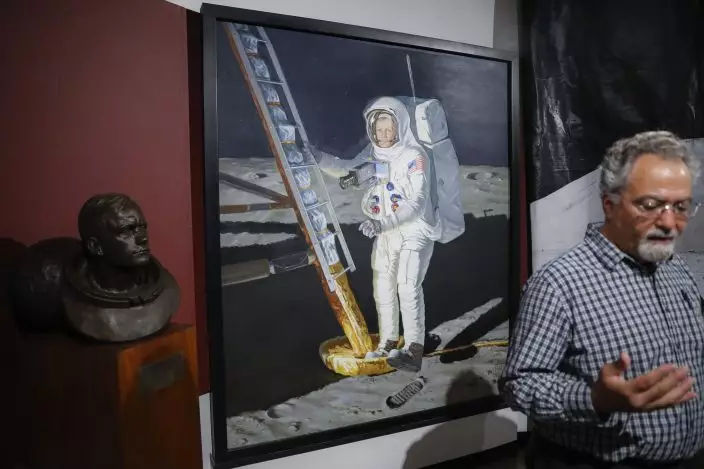
A portrait of astronaut Neil Armstrong stepping onto the surface of the moon is displayed behind museum director Dante Centuori, right, at the Armstrong Air & Space Museum, Wednesday, June 26, 2019, in Wapakoneta, Ohio. Neil Armstrong helped put Wapakoneta on the map July 20, 1969, when he became the first human to walk on the moon. The late astronaut remains larger than life in the city 60 miles (96.56 kilometers) north of Dayton, where visitors are greeted by the space base-shaped top of the space museum named for him as they exit Interstate 75. (AP PhotoJohn Minchillo)

A moon rock is displayed within a glass case at the Armstrong Air & Space Museum, Wednesday, June 26, 2019, in Wapakoneta, Ohio. Neil Armstrong helped put Wapakoneta on the map July 20, 1969, when he became the first human to walk on the moon. The late astronaut remains larger than life in the city 60 miles (96.56 kilometers) north of Dayton, where visitors are greeted by the space base-shaped top of the space museum named for him as they exit Interstate 75. (AP PhotoJohn Minchillo)
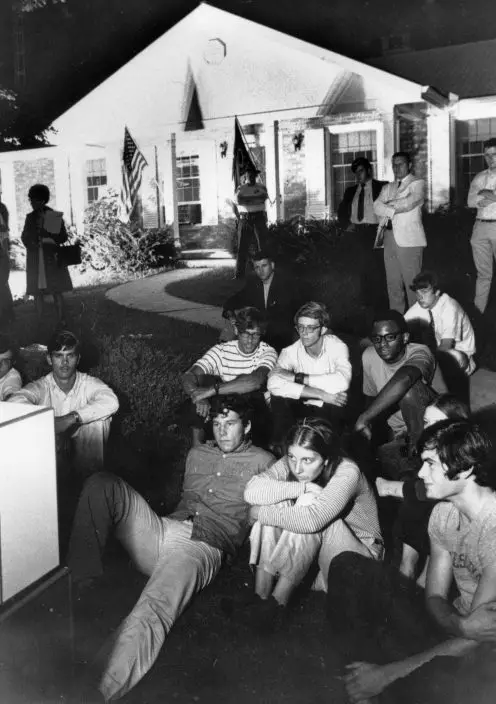
FILE - In this July 20, 1969 file photo, people sit on the lawn of the home of Stephen Armstrong in Wapakoneta, Ohio, to watch astronaut Neil Armstrong walk on the moon. Neil Armstrong helped put Wapakoneta on the map July 20, 1969, when he became the first human to walk on the moon. The late astronaut remains larger than life in the city 60 miles (96.56 kilometers) north of Dayton, where visitors are greeted by the space base-shaped top of the space museum named for him as they exit Interstate 75. (AP PhotoBill Sauro)
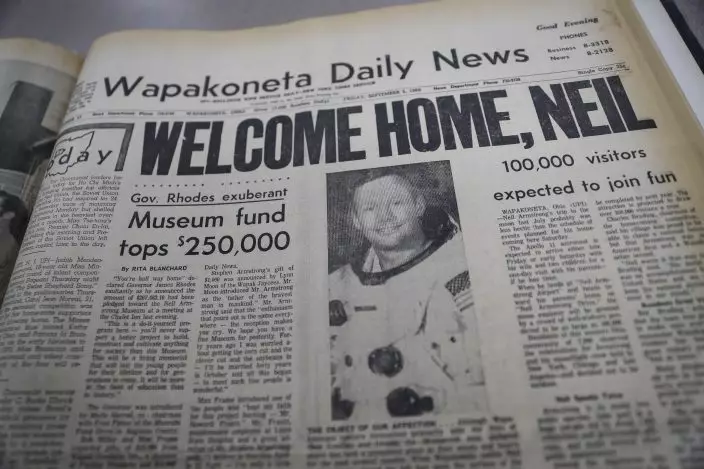
The front page of the Wapakoneta Daily News, dated Sept. 6, 1969, is photographed at the Auglaize County Public Library archives, Wednesday, June 26, 2019, in Wapakoneta, Ohio. Very down to earth about most things, folks in this small western Ohio city are over the moon as they get ready to celebrate the 50th anniversary of the day they watched their hometown hero along with the world. Neil Armstrong put Wapakoneta on the map in July 1969 when he became the first human to walk on the moon. (AP PhotoJohn Minchillo)
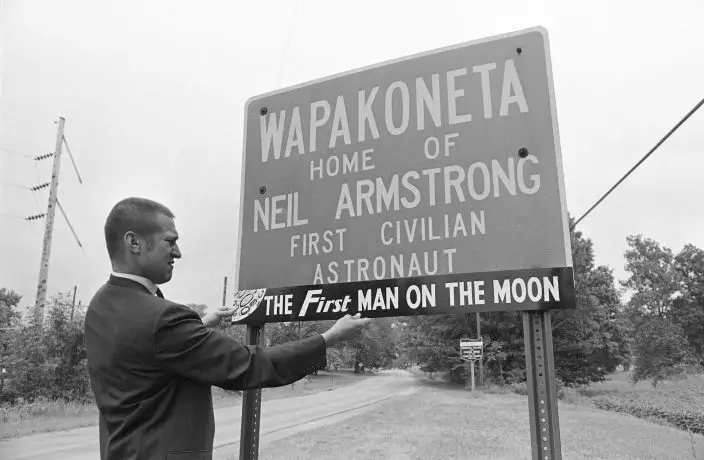
FILE - In this July 21, 1969 file photo, Charles Brading, a druggist and personal friend of astronaut Neil Armstrong, checks the size and placing of a temporary sign addition proclaiming their local hero in Wapakoneta, Ohio. Neil Armstrong helped put Wapakoneta on the map July 20, 1969, when he became the first human to walk on the moon. The late astronaut remains larger than life in the city 60 miles (96.56 kilometers) north of Dayton, where visitors are greeted by the space base-shaped top of the space museum named for him as they exit Interstate 75. (AP PhotoGEH)
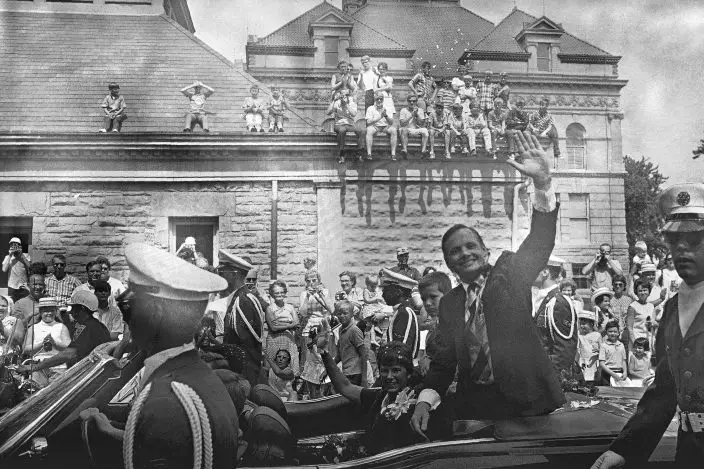
FILE - In this Sept. 6, 1969 file photo, people sit on the roof ledge of the Auglaize County Courthouse to cheer hometown hero Neil Armstrong waving to the crowd during a parade honoring him for his moon-walk feat. Also shown is his wife, Jan, and son, Eric, in the parade in Wapakoneta, Ohio. Neil Armstrong helped put Wapakoneta on the map July 20, 1969, when he became the first human to walk on the moon. The late astronaut remains larger than life in the city 60 miles (96.56 kilometers) north of Dayton, where visitors are greeted by the space base-shaped top of the space museum named for him as they exit Interstate 75. (AP Photo)


